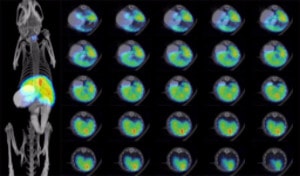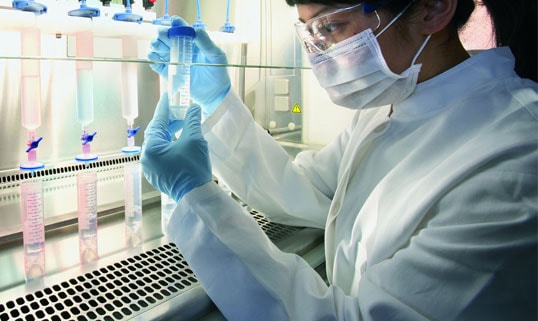LL/2-Fluc-Neo/eGFP-Puro
- Frozen / Standard (CL073-STAN) $ 2,100
Species: Mouse
Cell type: Lewis Lung Carcinoma
Transgenes: Firefly luciferase (Fluc) with neomycin resistance (Neo) for selection with G418 and enhanced green fluorescent protein (eGFP) with puromycin resistance (Puro) for selection with puromycin
Media: DMEM, 10% FBS, 1% Pen/Strep, 1.25mg/mL G418, 2μg/mL puromycin
Description: LL/2-Fluc-Neo/eGFP-Puro is a polyclonal population of the Lewis lung carcinoma cell line LL/2 (ATCC® CRL-1642™), also commonly known as LLC1, transduced with LV-Fluc-P2A-Neo (LV011) encoding the firefly luciferase (Fluc) cDNA under the spleen focus-forming virus (SFFV) promoter linked to the neomycin resistance gene (Neo) via a P2A cleavage peptide and LV-eGFP-PGK-Puro (LV031) encoding enhanced green fluorescent protein (eGFP) cDNA under the spleen focus-forming virus (SFFV) promoter and the puromycin resistance gene (Puro) under control of the PGK promoter.
The lentiviral vectors used are self-inactivating (SIN) vectors in which the viral enhancer and promoter has been deleted. Transcription inactivation of the LTR in the SIN provirus increases biosafety by preventing mobilization by replication competent viruses and enables regulated expression of the genes from the internal promoters without cis-acting effects of the LTR (Miyoshi et al., J Virol. 1998).
Cell Line Authentication: The parental LL/2 cell line was authenticated and certified free of interspecies cross-contamination by short tandem repeat (STR) profiling with 27 STR loci.
Recommended uses:
In vitro: This is a high Fluc/eGFP expressing cell line suitable for use as a positive control cell line in bioluminescence and fluorescence assays to verify luciferase and GFP expression respectively in your lentiviral transduced cells.
In vivo: LL/2 cells form tumors post implantation into immunocompromised or syngeneic C57BL/6 mice. The in vivo growth of these metastases can be monitored using non-invasive bioluminescent imaging with D-luciferin substrate. In vivo imaging for GFP fluorescence is not recommended due to high background autofluorescence. Tissues may be harvested post mortem for analysis by conventional microscopy.
For in vivo imaging in immunocompetent animals, please use the nonimmunogenic murine NIS reporter gene.
References on NIS imaging:
1. Fruthwirth et al. A whole body dual modality radionuclide optical strategy for preclinical imaging of metastasis and heterogeneous treatment responses in different. microenvironments. J. Nucl. Med 2014. 55(4): 686-94.
2. Penheiter et al. The sodium iodide symporter (NIS) as an imaging reporter for gene, viral and cell-based therapies. Curr Gene Ther. 2012, 12(1):33-47.
Publications that used associated reagents:
LV-eGFP-PGK-Puro (LV031): Shen et al. Immunovirotherapy with vesicular stomatitis virus and PD-L1 blockade enhances therapeutic outcome in murine acute myeloid leukemia. Blood. 2016. March 17: 127(11): 1449-58.
Morphology: Low- and high-density cell morphology (200x)

Flow Cytometry for eGFP: LL/2-Fluc-Neo/eGFP-Puro (green) or control (grey) cells were fixed with paraformaldehyde and analyzed by flow cytometry (20,000 events).

Luciferase Assay: 104, 105, or 106 cells were placed in wells of a 96-well plate and 0.3 mg of d-luciferin was added to the indicated wells. The plate was immediately imaged using a Xenogen IVIS Spectrum.

Bioluminescent images of a subcutaneous LL/2-Fluc-Puro tumor in an athymic mouse

1e7 LL/2-Fluc-Puro cells (Imanis Life catalog #CL050) were injected subcutaneously into the right flanks of female NCR athymic mice. Mice were imaged at day 0 on the day of cell implantation and at day 7 using a Perkin Elmer IVIS® Spectrum system, at 10-15 minutes post intraperitoneal injection of D-luciferin at 150 mg/kg. Tumor size was measured using calipers. Data from a representative mouse (ID#6867) is shown.

